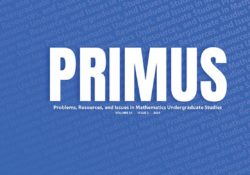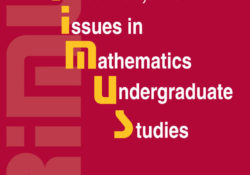tandfonline.com har udgivet en rapport under søgningen “Teacher Education Mathematics”: Specification Search in Structural Equation Modeling (SEM): How Gradient Component-wise Boosting can Contribute Link til kilde
Like this:
Like Loading...
tandfonline.com har udgivet en rapport under søgningen “Teacher Education Mathematics”: ABSTRACT ABSTRACT The purpose of this research is to investigate prospective teachers’ learning in the statistical modeling process. To reach this goal, we position the study in a socio-critical perspective of modeling that informed the design of a statistical investigation. Participants were 10 prospective teachers from a state university in northwestern Colombia who were taking a methods course in statistics. They worked out a statistical investigation inspired by a news article on global warming. The main source of data was fragments from prospective teachers’ speech while working out the statistical investigation. The information was complemented with prospective teachers’ narratives in which they reflected on their experience with statistics. The results reveal that the prospective teachers’ discourse offers indications to suggest… Continue Reading →
Like this:
Like Loading...

tandfonline.com har udgivet en rapport under søgningen “Teacher Education Mathematics”: Abstract Formulae display:?Mathematical formulae have been encoded as MathML and are displayed in this HTML version using MathJax in order to improve their display. Uncheck the box to turn MathJax off. This feature requires Javascript. Click on a formula to zoom. Abstract Statistical modeling continues to gain prominence in the secondary curriculum, and recent recommendations to emphasize data science and computational thinking may soon position algorithmic models into the school curriculum. Many teachers’ preparation for and experiences teaching statistical modeling have focused on probabilistic models. Subsequently, much of the research literature related to the teachers’ understanding has focused on probabilistic models. This study explores the extent to which secondary statistics teachers appear to understand ideas of statistical modeling, specifically the… Continue Reading →
Like this:
Like Loading...
tandfonline.com har udgivet en rapport under søgningen “Teacher Education Mathematics”: ABSTRACT Formulae display:?Mathematical formulae have been encoded as MathML and are displayed in this HTML version using MathJax in order to improve their display. Uncheck the box to turn MathJax off. This feature requires Javascript. Click on a formula to zoom. ABSTRACT The COVID-19 pandemic has made mathematical epidemiology a topic of critical importance, providing mathematics educators with an unparalleled opportunity. This opportunity is accompanied by a challenge: how do mathematics educators, some of whom have little personal experience with mathematical modeling, teach mathematical epidemiology to their students in courses ranging from precalculus to differential equations, and do so in a way that builds understanding of epidemic disease dynamics as well as mathematical methods? We address this issue with a… Continue Reading →
Like this:
Like Loading...
tandfonline.com har udgivet en rapport under søgningen “Teacher Education Mathematics”: Abstract Formulae display:?Mathematical formulae have been encoded as MathML and are displayed in this HTML version using MathJax in order to improve their display. Uncheck the box to turn MathJax off. This feature requires Javascript. Click on a formula to zoom. Abstract Students learn many concepts in the introductory statistics course, but even our most successful students end up with rigid, ritualized knowledge that does not transfer easily to new situations. In this article we describe our attempt to apply theories and findings from learning science to the design of a statistics course that aims to help students build a coherent and interconnected representation of the domain. The resulting practicing connections approach provides students with repeated opportunities to practice connections… Continue Reading →
Like this:
Like Loading...
tandfonline.com har udgivet en rapport under søgningen “Teacher Education Mathematics”: ABSTRACT ABSTRACT Character portrayals are important to consider when investigating the effects of educational television on young viewers. When it comes to academic interests and career aspirations, children take cues from the media representations around them. This study is a content analysis of STEM-focused children’s television shows, with attention to gender and race representation amongst the characters in those programs. Across 90 episodes of programs that claim to teach STEM to young children, 1,086 unique speaking characters were coded on demographics, physical attributes, centrality to the plot, and modeling of STEM behaviors and occupations. Following traditional industry trends, female and minority characters were underrepresented in these programs compared to population statistics. However, when it came to the centrality of their… Continue Reading →
Like this:
Like Loading...
eric.ed.gov har udgivet: A key element in science education is establishing and maintaining linkages between teachers and researchers that can eventuate in enhanced student outcomes. Determining when and where a new educational program or intervention results in an enhanced outcome can be sensitive to many different forces that the researcher must carefully manage. The target of inquiry-based approach is to increase cognitive abilities such as critical thinking. However, students, teachers, and schools are evaluated based on content student knowledge. Statistical modeling choices affect the ability to determine the efficacy of the intervention and the ability to identify those students who receive the greatest and least benefit from the intervention. As it is imperative to determine how an increase in cognitive abilities corresponds to an increase in content across different demographics… Continue Reading →
Like this:
Like Loading...
tandfonline.com har udgivet en rapport under søgningen “Teacher Education Mathematics”: Link til kilde
Like this:
Like Loading...
eric.ed.gov har udgivet: The purpose of this paper is to explain how to use the scientific method as the framework to introduce mathematical model. Two interdisciplinary activities, targeted for students in grade 6 or grade 7, are explained to show the application of the scientific method while building a mathematical model to investigate the relationship between the circumferences and the diameter of circular objects. In the first activity, a research question is pursued as it relates to the stated hypothesis. In the second activity, the same research question is retained; however, the use of exploration helps to build the hypothesis. The activities serve as examples to show how middle school math teachers may use scientific inquiry to motive students’ understanding of mathematical models as well as engage in science beyond… Continue Reading →
Like this:
Like Loading...
tandfonline.com har udgivet en rapport under søgningen “Teacher Education Mathematics”: The relationship between EFL teachers’ continuing professional development and their self-efficacy: A structural equation modeling approach Link til kilde
Like this:
Like Loading...







